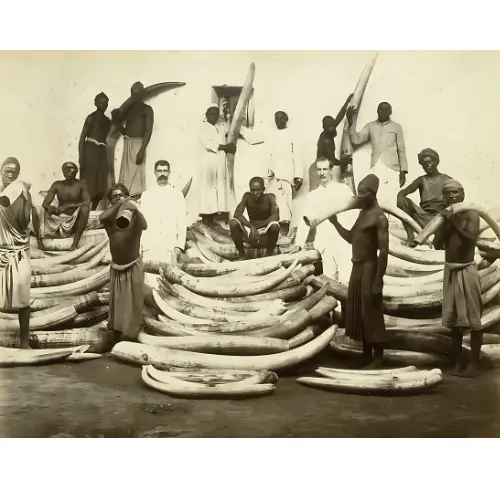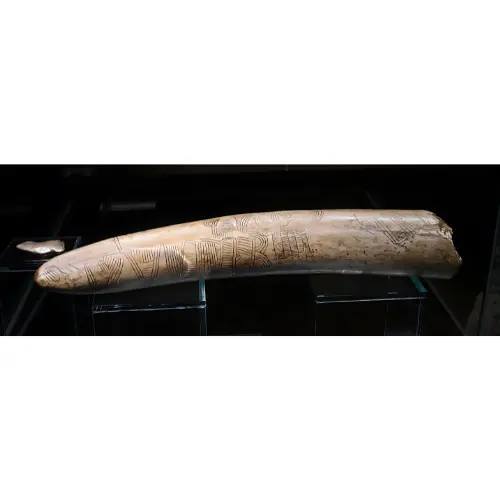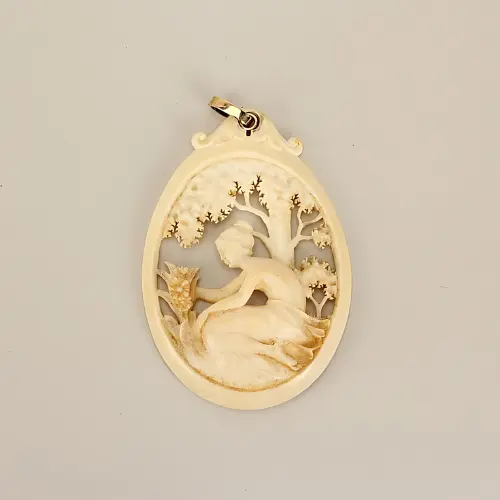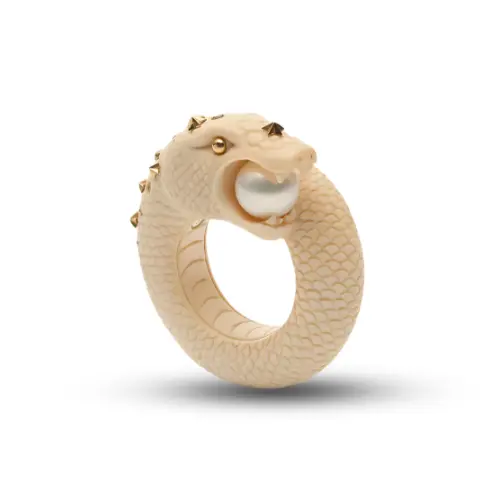
Ivory jewelry has been revered for centuries for its unparalleled beauty, intricate craftsmanship, and timeless elegance. From ancient civilizations to modern fashion runways, ivory pieces have adorned the wealthy and the powerful, symbolizing status and luxury. However, beneath the lustrous surface of these beautiful artifacts lies a troubling history of exploitation and environmental devastation. This blog delves into the dual nature of ivory jewelry, exploring both its historical significance and the pressing ethical concerns surrounding its use.
Historical Significance

Historically, ivory, an organic gem material, was exclusively sourced from elephant tusks. However, with elephants now protected and the sale of elephant ivory banned, contemporary ivory used in jewelry primarily comes from fossilized sources and the teeth of other animals like hippopotamuses, narwhals, sea lions, and wild boars.
Ivory is recognizable by its distinctive grain pattern, known as the “engine-turned effect,” which differentiates it from bone. Over time, ivory transitions from its original white color to a yellowish hue, eventually developing a brownish patina as it ages. Its value lies in its exceptional carveability, which has given rise to numerous fine ivory carving traditions worldwide. Notable examples include netsukes from Japan, Victorian carvings, the Erbach school in Germany, and centuries-old carvings of mammoth and walrus ivory in Russia.
Ivory has been prized since antiquity for its smooth texture and ease of carving. Ancient Egyptians, Greeks, and Romans crafted ivory into a variety of items, including jewelry, figurines, and religious artifacts. During the medieval period, ivory was a favorite material for the creation of religious icons and ceremonial objects.
In many cultures, ivory was also believed to possess mystical properties. It was often used in the creation of amulets and talismans believed to bring good fortune, protection, and healing. The beauty and mystique of ivory ensured its place as a highly coveted material across different eras and societies.
Ivory Trade

Ivory has been traded for thousands of years, valued for its beauty, durability, and workability. Ancient civilizations such as the Egyptians, Greeks, and Romans highly prized ivory, using it to create a variety of items, from jewelry and religious artifacts to decorative objects. The demand for ivory surged during the Age of Exploration, as European powers sought exotic goods from Africa and Asia.
By the 19th and early 20th centuries, the ivory trade had become a significant economic activity, particularly in Africa. Colonial powers and traders hunted elephants extensively to satisfy the growing demand for ivory in Europe and America, where it was used in everything from piano keys to billiard balls and fine art.The demand for ivory has had a catastrophic impact on elephant populations. In the early 20th century, the global elephant population was estimated to be in the millions. However, rampant poaching driven by the lucrative ivory market led to a dramatic decline. By the 1970s and 1980s, elephant numbers had plummeted, pushing many populations to the brink of extinction.

Elephants are keystone species, meaning their presence is crucial for maintaining the structure of the ecosystems in which they live. The decimation of elephant herds not only disrupts these ecosystems but also threatens the biodiversity of entire regions.
In response to the alarming decline in elephant populations, international efforts have been made to regulate and ban the ivory trade. The Convention on International Trade in Endangered Species of Wild Fauna and Flora (CITES) played a pivotal role in these efforts. In 1989, CITES enacted a global ban on the international trade of ivory, with some exceptions for pre-existing ivory and certain controlled circumstances.
Many countries have implemented their own domestic bans and stricter regulations to combat illegal ivory trading. For example, the United States and China, two of the largest markets for ivory, have introduced comprehensive bans on the sale and purchase of ivory within their borders.
Despite these efforts, illegal ivory trade persists, often linked to organized crime and corruption. The high value of ivory continues to drive poaching, posing significant challenges to enforcement and conservation efforts.
Craftsmanship and Design

The appeal of ivory jewelry lies not only in the material itself but also in the remarkable skill required to shape it. Craftsmen have developed techniques over centuries to carve intricate patterns, delicate figures, and detailed motifs into ivory. This craftsmanship turns a piece of ivory into a work of art, showcasing the artisan’s talent and the material’s unique qualities.
Traditional designs often draw inspiration from nature, mythology, and cultural symbols. Modern ivory jewelry, while rarer due to legal restrictions, continues to inspire with contemporary designs that pay homage to its rich heritage.
Ethical Concerns and Conservation Efforts
The dark side of ivory jewelry's allure is its impact on elephant populations. Ivory is primarily sourced from elephant tusks, and the demand for ivory has led to the widespread poaching of elephants, pushing these majestic creatures toward the brink of extinction. The illegal ivory trade is a lucrative business that fuels organized crime and violence, further exacerbating the problem.
Recognizing the urgent need to protect elephants, international regulations have been put in place. The Convention on International Trade in Endangered Species of Wild Fauna and Flora (CITES) has implemented strict controls and bans on the international trade of ivory. Many countries have also enacted domestic laws to curb ivory sales and promote alternative materials.
Alternatives to Ivory

Given the ethical implications, many jewelers and consumers are turning to alternatives that mimic the appearance of ivory without the associated guilt. These include materials like:
Fossilized Ivory: Sourced from mammoth tusks found in permafrost, this provides a similar aesthetic without harming living elephants.
Bone: Carved bone can replicate ivory's look and feel and is often sourced from animals that have died of natural causes.
Synthetic Ivory: Man-made materials designed to mimic the properties of ivory offer an ethical and sustainable option for jewelry enthusiasts.

Ivory jewelry, with its deep historical roots and exquisite craftsmanship, undeniably holds a special place in the world of adornment. However, the ethical concerns surrounding its acquisition and the impact on wildlife have cast a long shadow over its beauty. As we move forward, it is crucial to balance our appreciation for this art form with a commitment to conservation and sustainability.
By embracing alternatives and supporting ethical practices, we can ensure that the legacy of ivory jewelry is one of respect for both the artistry it represents and the natural world it once came from. Let us celebrate the beauty of craftsmanship while also cherishing and protecting the magnificent creatures that have long been the source of this elegant material.
You may also like,
THE TIMELESS ALLURE OF PALM JEWELRY
EXPLORING THE RICH HERITAGE OF ETHIOPIAN JEWELRY
KASHMIR SAPPHIRE: UNVEILING THE MYSTIQUE OF THE HIMALAYAN GEM







